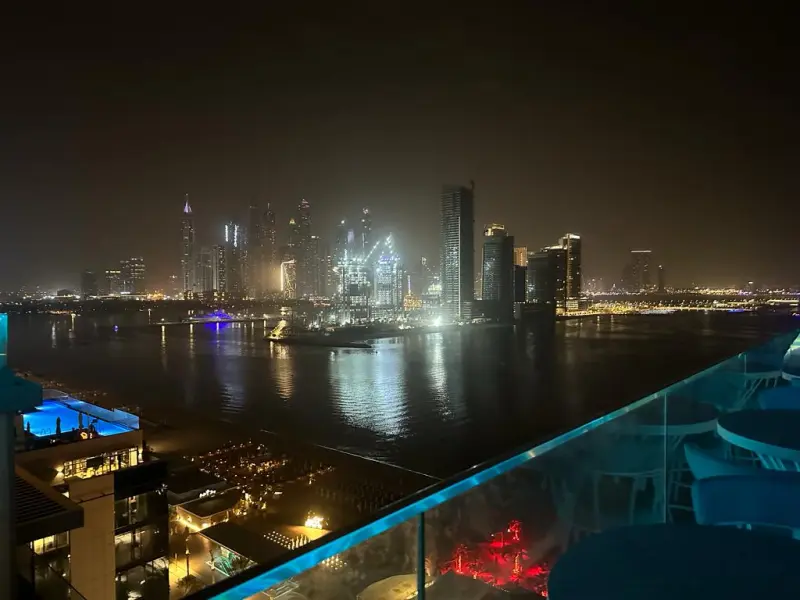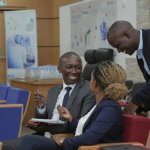This article was first published by Kenya Broadcasting Commission (KCB)
The varying global climatic patterns this year saw me escape the worrying cold in Nairobi to briefly experience the lush of sunshine and hot weather in the Middle East and later in Europe. As I stepped off one of the majestic Emirates Boeing 777 into the crisp, clean interior of Dubai International Airport (DXB), I felt a rush of excitement for what lay ahead. My solo-travel summer trip to the jewel cities of the United Arab Emirates – Dubai and Abu Dhabi – was filled with many firsts. As a curious journalist from Kenya, I was eager to explore these global powerhouses and to witness firsthand what Africa could learn from them. So my trip was not merely a vacation. It was as well an exploration of how Dubai and Abu Dhabi have leveraged their unique strengths to build global cities, preserve their cultural heritage, and pave the way towards a sustainable future. As an African, it served as a thought-provoking comparison, offering lessons that could be applied to our own unique context.
The futuristic skyline of Dubai, punctuated by the gleaming Burj Khalifa, was my first surprise. This city, built in the span of just a few decades, stood as a testament to what can be achieved through ambitious vision, effective planning, and dogged determination. Dubai felt like a love letter to human audacity written in steel and glass. A similar sentiment echoed through the well-planned streets of Abu Dhabi, where the Sheikh Zayed Grand Mosque, a blend of modern and traditional Islamic architecture, majestically sat.
The much-needed development: A tale of two continents
The Emirati journey to becoming a global economic powerhouse can serve as a beacon of inspiration for African nations. Dubai’s transformation from a simple pearling community to an international business hub demonstrates the transformative power of innovative policies and effective governance.
A demonstration of this is the iconic Burj Khalifa. Towering at an awe-inspiring 828 meters, it is a marvel of modern engineering and a symbol of Dubai’s meteoric rise. The conception and execution of such an ambitious project sends a clear message: with the right vision and drive, even the most audacious dreams can become a reality. African cities like Nairobi and Mombasa could borrow from this bold approach, embracing innovative architecture and urban planning to transform their skylines. Do we have the talent? Yes! I met a number of Kenyans, including an engineer cousin of mine who was part of the large team involved in the foundational excavation of the tower in 2004. Maybe the talented workforce in UAE from Kenya is something we can talk about some other day.
In Abu Dhabi, the integrated transportation system is a lesson to take home. The city’s efficient and well-connected network of trams, buses, and taxis serves as a reminder that effective transportation is a cornerstone of urban development. The existence of futuristic public transport systems, such as Dubai’s driverless metro system, and Abu Dhabi’s integrated transportation, is a clear display of sustainable urban development that African cities could emulate. By investing in sustainable public transport systems, African cities could not only reduce traffic congestion and pollution but also improve the quality of life for their residents.
Read also: Unleashing Africa’s innovative potential: empowering sustainability and climate change solutions
Cultural conservation amidst modernization
In the midst of these gleaming skyscrapers and ultra-modern conveniences, the UAE has managed to preserve its cultural heritage brilliantly. This marriage between the old and the new was beautifully symbolized in the Dubai Museum, housed in the 200-year-old Al Fahidi Fort. The Ibn Battuta Mall in Dubai provides a fascinating insight into the successful merging of tradition and modernity. The mall, named after the famous Moroccan explorer, Ibn Battuta, is divided into six courts, each reflecting the architecture and culture of the regions he travelled to. This unique blend of commerce, culture, and history provides a blueprint for how African nations can modernize without sacrificing their rich heritage.
Similarly, the Sheikh Zayed Grand Mosque in Abu Dhabi serves as a proud testament to the UAE’s Islamic heritage. The mosque’s design, which blends modern and traditional Islamic architecture, provides a blueprint for how Africa’s diverse cultural and religious landmarks can adapt to the 21st century without losing their essence. I found myself enthralled by the local Bedouin culture, and their conservation efforts reminded me of our own rich African heritage.
As we grapple with the strain of modernity on our traditions, perhaps we can borrow a leaf from the Emiratis. By emphasizing cultural education and promoting local arts and traditions, we can also strike a balance between progress and tradition.
Policies and laws: Lessons in structure
On a more serious note, the governance model of the UAE, while different from our democratic model in Africa, has undeniably played a significant role in their rapid growth. The UAE’s governance model presents a mix of lessons for African nations. They’ve demonstrated strong leadership, zero-tolerance to corruption, and a clear long-term vision – all elements that could serve to bolster African governance, particularly in promoting transparency and enforcing stricter anti-corruption measures.
I would be remiss if I didn’t address the proverbial elephant in the room – the restrictive aspects of Emirati laws. Their strict policies have drawn global attention, sometimes for the wrong reasons. The balance between maintaining law and order and ensuring individual freedoms is a delicate one, and this is something African countries could navigate more effectively, drawing lessons from the UAE.
Sustainability and future trends
Sustainability has become a catchphrase in recent years, and rightly so. Like I earlier mentioned, our world, Africa included, is grappling with climate change, biodiversity loss, and environmental degradation. My visit to the Museum of the Future in Dubai was a window into the UAE’s commitment to a sustainable future. This museum, with its exhibitions on climate change, renewable energy, and other pressing global issues, showed a clear dedication to tackling these challenges head-on. Here in the middle of a desert, the UAE is really making strides. Solar power plants sprawled across vast stretches of sand, massive desalination plants hummed along the coastlines, and strict waste management policies are in place. The 2020 World Expo, themed “Connecting Minds, Creating the Future” was a clear commitment to their drive to sustainability.
In the same spirit, Africa can also adopt a forward-thinking approach to these issues. The continent is rich in renewable energy resources, such as solar and wind, which could be harnessed to power our cities and towns. Kenya, in particular, has made strides in this area, with the Lake Turkana Wind Power project and the geothermal energy plants in the Rift Valley. By scaling up these efforts, we can ensure a cleaner, more sustainable future for our continent. This is not all; While we have a rich reservoir of natural resources, we must harness them sustainably, for the sake of future generations.
Interesting to read: Bridging the energy gap in Africa: Lessons from Sierra Leone’s mini-grids sector
And amidst the high-rises…
Now, allow me to switch gears to the lighter side of my journey, for every trip has its comical aspects. Strolling through the gold souk in Deira, I was struck by the extravagant displays of gold and gems. I chuckled at the thought of Nairobi’s Gikomba Market traders trying to sell dazzling diamond necklaces alongside the clothes. Then there was the visit to Ferrari World in Abu Dhabi, home to the fastest roller coaster in the world. As I screamed my lungs out on the Formula Rossa, reaching speeds of 240 km/h, I couldn’t help but compare it to our matatu culture back home. Our matatu drivers, notorious for their need for speed, would feel right at home on this thrilling ride!
And the camel rides… As a Kenyan used to our ‘beasts of burden’, the donkeys in Limuru and Naivasha, although my friend Arnold promised me that we would this year be attending the Maralal International Camel Derby in the Northern Kenya and I will be waiting to see if I can trade our trusty donkeys for camels anytime soon.
Anyway, as we strive to build our future in Africa, let’s do so with a keen eye on sustainability, a firm grip on our rich heritage, and a clear vision for the future. And in the midst of all this serious work, let’s not forget to have a good laugh – after all, life is not merely about the destination, but also about the journey!



